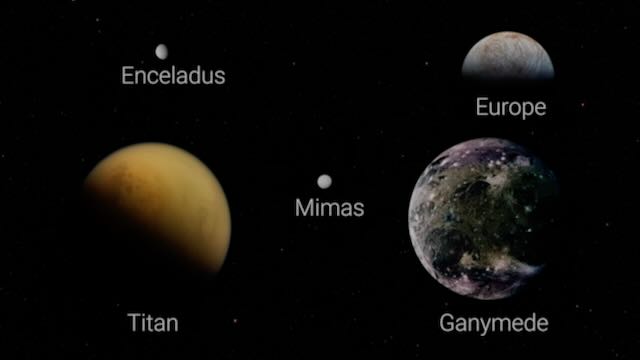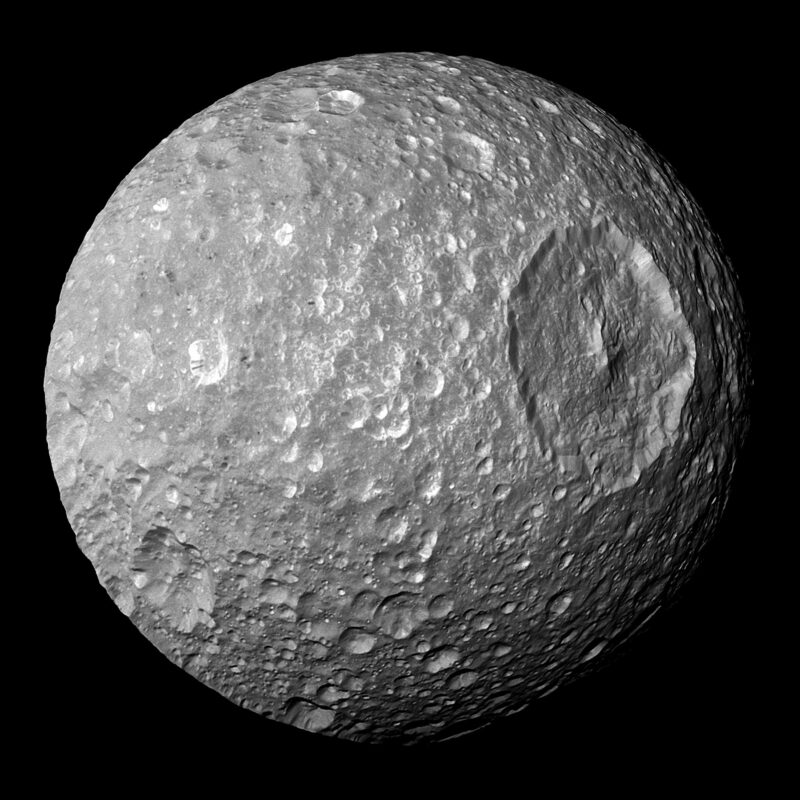Mimas has an ocean! Wow!
Key points about Mimas’ ocean
- Saturn’s moon Mimas has a hidden ocean, only 20 to 30 kilometers (12-18 miles) below its heavily cratered and icy surface.
- The little moon’s ocean probably formed relatively recently, only 5 to 15 million years ago, due to tidal “squeezing” of Mimas by Saturn.
- Mimas is now the smallest of the known moons with an ocean. It’s another place to look for life in our solar system!
2024 lunar calendars on sale now. Makes a great gift! Check it out here.
Mimas has a hidden ocean
All these years, Saturn’s small moon Mimas has had a secret. Beneath this little moon’s heavily cratered surface lies a global ocean of liquid water. Astronomer Valéry Lainey of the Observatoire de Paris-PSL and his team made this discovery by analyzing data from the Cassini spacecraft, which orbited Saturn, weaving among its moons, from 2004 to 2017. The work reveals a “young” ocean formed just 5 to 15 million years ago, making Mimas a prime target for studying the origin of life in our solar system.
Lainey et al. published their work in the peer-reviewed journal Nature on February 7, 2024.
Astronomer Nick Cooper – at Queen Mary University of London – is a co-author on the study. He commented:
Mimas is a small moon, only about 400 kilometers [250 miles] in diameter. And its heavily cratered surface gave no hint of the hidden ocean beneath. This discovery adds Mimas to an exclusive club of moons with internal oceans, including Saturn’s moon Enceladus and Jupiter’s moon Europa. But with a unique difference: Mimas’ ocean is remarkably young, estimated to be only 5 to 15 million years old.

A young ocean for a tiny moon
Astronomers confirmed the existence of Mimas’ ocean – and the young age of the ocean – through detailed analysis of tidal interactions between Mimas and Saturn. In other words, Saturn’s gravity squeezes the little moon, as the moon orbits the planet. The work suggests the ocean formed recently. And it’s only been recently that two other Saturn moons – Enceladus and Tethys – disturbed Mimas’ orbit, sending it into an orbit that would allow Saturn to squeeze it so effectively.
Scientists say the young age of the ocean gives them a unique window into the early stages of ocean formation and the potential for life to emerge. Cooper explained:
The existence of a recently formed liquid water ocean makes Mimas a prime candidate for study, for researchers investigating the origin of life.
The scientists made the discovery by analyzing data from NASA’s Cassini spacecraft, which meticulously studied Saturn and its moons for over a decade. By closely examining the subtle changes in Mimas’ orbit, the researchers were able to infer the presence of a hidden ocean and estimate its size and depth. For details on how they made the discovery, watch the video below:
What does Mimas mean for life?
The scientists agree that the discovery of Mimas’ young ocean might help us increase our understanding of the potential for life beyond Earth.
The existence of an ocean in such a small moon suggests that even small, seemingly inactive moons can harbor hidden oceans capable of supporting life-essential conditions.
So the hidden ocean of the little moon Mimas opens up exciting new avenues for future exploration. It might lead us closer to answering the age-old question: are we alone in the universe?

Bottom line: Saturn’s moon Mimas has now become the smallest moon known to harbor a hidden ocean of liquid water beneath its icy surface. Scientists made the discovery using Cassini spacecraft data.











